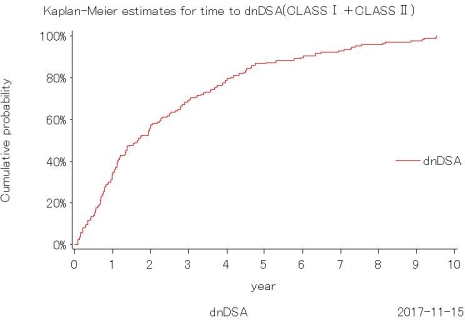Influence of Trough Level in Tacrolimus on the Appearance Rate of De Novo Donor Specific Antibody (dnDSA) under Low Dose-Based Tacrolimus Protocol during 7 Years Follow-Up after Renal Transplantation
1Organ Transplantation Medicine, Tokyo Women's Medical University, Tokyo, Japan
2Urology, Tokyo Women's Medical University, Tokyo, Japan.
Meeting: 2018 American Transplant Congress
Abstract number: C84
Keywords: HLA antibodies, Immunosuppression, Kidney transplantation
Session Information
Session Name: Poster Session C: Kidney Immunosuppression: Novel Regimens and Drug Minimization
Session Type: Poster Session
Date: Monday, June 4, 2018
Session Time: 6:00pm-7:00pm
 Presentation Time: 6:00pm-7:00pm
Presentation Time: 6:00pm-7:00pm
Location: Hall 4EF
Background. Tacrolimus low trough protocol has been adopted at our institution since 2000.The purpose in this study is to investigate the relationship between maintenance trough level in tacrolimus and the appearance rate of dn DSA during follow-up 7.6±1.8 after Tx.
Materials and Methods. Total 584 recipients (group 1 no-dn DSA, N=420; group 2 dnDSA, N=164) who were transplanted from living donors at our single center between 2000 and 2015 and were followed-up with regular renal biopsies and regular monitoring for DSA detected by SPA, were included in this study.
We investigated incidence rate of dn DSA according to recipient's sensitized immunological status and immunosuppressive regimen used as well as maintenance trough level in tacrolimus.
Results. Dn DSA in group 2 appeared at 812±102 days on average. The number of mismatches in HLA-A/B/C/DR/DQ was significant more in group 2 than in group 1 (2.8±1.5 in group 1 vs. 3.4±1.3 in group 2; P<0.001). Patients with preformed DSA showed higher incidence rate of de novo DSA production (27.1 % in group 1, vs. 48.2 % in group 2. P<0.001). Graft function has been significantly much worse in group 2 than in group 1, since 1 to 3 years. Graft biopsies revealed much more incidence rate and severer findings of acute and/or chronic TCMR and ABMR in group 2 recipients. Death censored-graft failure was higher in group 2 than in group 1 (18/420, 4.3 % in group1 vs. 28/164, 17. 1% in group 2, P<0.001). We cannot find any significant relationship between immunosuppressive regimens including rituximab or trough level in tacrolimus and incidence rate of de novo DSA production.
The number of mismatches in HLA-A/B/C/DR/DQ was significant more in group 2 than in group 1 (2.8±1.5 in group 1 vs. 3.4±1.3 in group 2; P<0.001). Patients with preformed DSA showed higher incidence rate of de novo DSA production (27.1 % in group 1, vs. 48.2 % in group 2. P<0.001). Graft function has been significantly much worse in group 2 than in group 1, since 1 to 3 years. Graft biopsies revealed much more incidence rate and severer findings of acute and/or chronic TCMR and ABMR in group 2 recipients. Death censored-graft failure was higher in group 2 than in group 1 (18/420, 4.3 % in group1 vs. 28/164, 17. 1% in group 2, P<0.001). We cannot find any significant relationship between immunosuppressive regimens including rituximab or trough level in tacrolimus and incidence rate of de novo DSA production.
Conclusion. In this study, higher incidence rate of de novo DSA production was observed in recipients with prior sensitization and in D/R combination with more HLA mismatches. However, there were no clear relationship between immunosuppressive regimen or trough level in tacrolimus and incidence rate of de novo DSA production.
CITATION INFORMATION: Ishida H., Tanabe K., Shimizu T., Furusawa M. Influence of Trough Level in Tacrolimus on the Appearance Rate of De Novo Donor Specific Antibody (dnDSA) under Low Dose-Based Tacrolimus Protocol during 7 Years Follow-Up after Renal Transplantation Am J Transplant. 2017;17 (suppl 3).
To cite this abstract in AMA style:
Ishida H, Tanabe K, Shimizu T, Furusawa M. Influence of Trough Level in Tacrolimus on the Appearance Rate of De Novo Donor Specific Antibody (dnDSA) under Low Dose-Based Tacrolimus Protocol during 7 Years Follow-Up after Renal Transplantation [abstract]. https://atcmeetingabstracts.com/abstract/influence-of-trough-level-in-tacrolimus-on-the-appearance-rate-of-de-novo-donor-specific-antibody-dndsa-under-low-dose-based-tacrolimus-protocol-during-7-years-follow-up-after-renal-transplantation/. Accessed December 28, 2025.« Back to 2018 American Transplant Congress
